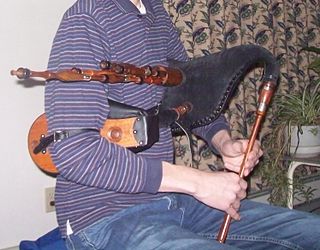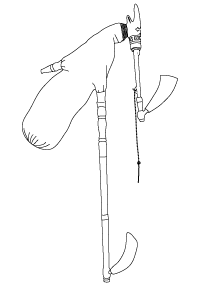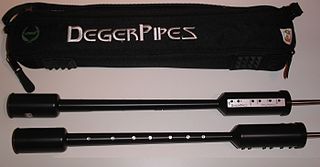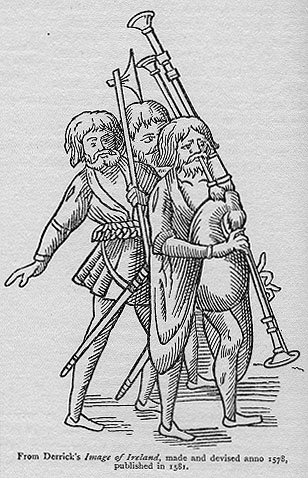
Bagpipes are a woodwind instrument using enclosed reeds fed from a constant reservoir of air in the form of a bag. The Great Highland bagpipes are well known, but people have played bagpipes for centuries throughout large parts of Europe, Northern Africa, Western Asia, around the Persian Gulf and northern parts of South Asia.

The uilleann pipes, also known as Union pipes and sometimes called Irish pipes, are the characteristic national bagpipe of Ireland. Their current name is a partial translation of the Irish language terms píobaí uilleann, from their method of inflation. There is no historical record of the name or use of the term uilleann pipes before the 20th century. It was an invention of Grattan Flood and the name stuck. People mistook the term 'union' to refer to the 1800 Act of Union; however, this is incorrect as Breandán Breathnach points out that a poem published in 1796 uses the term 'union'.

The great Highland bagpipe is a type of bagpipe native to Scotland, and the Scottish analogue to the great Irish warpipes. It has acquired widespread recognition through its usage in the British military and in pipe bands throughout the world.

The Scottish smallpipe is a bellows-blown bagpipe re-developed by Colin Ross and many others, adapted from an earlier design of the instrument. There are surviving bellows-blown examples of similar historical instruments as well as the mouth-blown Montgomery smallpipes, dated 1757, which are held in the National Museum of Scotland. Some instruments are being built as direct copies of historical examples, but few modern instruments are directly modelled on older examples; the modern instrument is typically larger and lower-pitched. The innovations leading to the modern instrument, in particular the design of the reeds, were largely taken from the Northumbrian smallpipes.

The border pipes are a type of bagpipe related to the Scottish Great Highland Bagpipe. It is perhaps confusable with the Scottish smallpipe, although it is a quite different and much older instrument. Although most modern Border pipes are closely modelled on similar historic instruments, the modern Scottish smallpipes are a modern reinvention, inspired by historic instruments but largely based on Northumbrian smallpipes in their construction.

The Northumbrian smallpipes are bellows-blown bagpipes from Northeastern England, where they have been an important factor in the local musical culture for more than 250 years. The family of the Duke of Northumberland have had an official piper for over 250 years. The Northumbrian Pipers' Society was founded in 1928, to encourage the playing of the instrument and its music; Although there were so few players at times during the last century that some feared the tradition would die out, there are many players and makers of the instrument nowadays, and the Society has played a large role in this revival. In more recent times the Mayor of Gateshead and the Lord Mayor of Newcastle have both established a tradition of appointing official Northumbrian pipers.

Zampogna is a generic term for a number of Italian double chantered bagpipes that can be found as far north as the southern part of the Marche, throughout areas in Abruzzo, Latium, Molise, Basilicata, Campania, Calabria, Apulia and Sicily. The tradition is now mostly associated with Christmas, and the most famous Italian carol, "Tu scendi dalle stelle" is derived from traditional zampogna music. However, there is an ongoing resurgence of the instrument in secular use seen with the increasing number of folk music festivals and folk music ensembles.
A Koza is the generic term for one of five basic types of bagpipes used in Polish folk music. The koza comes from the southern mountainous region of Poland known as Podhale and differs considerably from other types of bagpipes in its construction. Its scale is: b,c,d,e,f,g. The instrument is known for producing a continuous, low pitch.

A bagpipe practice chanter is a double-reed woodwind instrument, principally used as an adjunct to the Great Highland bagpipe. As its name implies, the practice chanter serves as a practice instrument: firstly for learning to finger the different melody notes of bagpipe music, and to practice new music.

The Hungarian duda is the traditional bagpipe of Hungary. It is an example of a group of bagpipes called Medio-Carparthian bagpipes.
Cornish bagpipes are the forms of bagpipes once common in Cornwall in the 19th century. Bagpipes and pipes are mentioned in Cornish documentary sources from c.1150 to 1830 and bagpipes are present in Cornish iconography from the 15th and 16th centuries.

The pastoral pipe was a bellows-blown bagpipe, widely recognised as the forerunner and ancestor of the 19th-century union pipes, which became the uilleann pipes of today. Similar in design and construction, it had a foot joint in order to play a low leading note and plays a two octave chromatic scale. There is a tutor for the "Pastoral or New Bagpipe" by J. Geoghegan, published in London in 1745. It had been considered that Geoghegan had overstated the capabilities of the instrument, but a study on surviving instruments has shown that it did indeed have the range and chromatic possibilities which he claimed.
The Brian Boru bagpipe was invented and patented in 1908 by Henry Starck, an instrument maker, in London, in consultation with William O'Duane. The name was chosen in honour of the Irish king Brian Boru (941–1014), though this bagpipe is not a recreation of any pipes that were played at the time of his reign.

Welsh bagpipes are a related instrument to one type of bagpipe, a chanter, which when played without the bag and drone is called a pibgorn. The generic term pibau which covers all woodwind instruments is also used in Welsh. They have been played, documented, represented and described in Wales since the fourteenth century. A piper in Welsh is called a pibydd or a pibgodwr.

The torupill is a traditional bagpipe from Estonia.
This article defines a number of terms that are exclusive, or whose meaning is exclusive, to piping and pipers.

The electronic bagpipes is an electronic musical instrument emulating the tone and/or playing style of the bagpipes. Most electronic bagpipe emulators feature a simulated chanter, which is used to play the melody. Some models also produce a harmonizing drone(s). Some variants employ a simulated bag, wherein the player's pressure on the bag activates a switch maintaining a constant tone. As with other electronic musical instruments, they must be plugged into an instrument amplifier and loudspeaker to hear the sound. Some electronic bagpipes are MIDI controllers that can be plugged into a synth module to create synthesized or sampled bagpipe sounds.

Irish warpipes are an Irish analogue of the Scottish great Highland bagpipe. "Warpipes" is originally an English term. The first use of the Gaelic term in Ireland was recorded in a poem by Seán Ó Neachtain, in which the bagpipes are referred to as píb mhór.

The term „Marktsackpfeife“ commonly refers to a type of bagpipe which has been developed in East Germany at the beginning of 1980s for the specific purpose to be played at faires and markets as a modern interpretation of a certain type of Medieval bapipes. Depictions of such bagpipes are found in Medieval sources and are characterized by specific features like wide flaring bells atop the chanter and drones, apparent conical shape of the chanter and reportedly substantial volume of their sound. Since no actual chanters of this type of bagpipe have survived and/or have been recovered so far, the MSP has to be classified as a purely modern musical instrument having a historically informed exterior. MSP chanters typically use double reeds made of plastic or Arundo donax cane and drones usually work with single reeds made of same materials. Chanter bores are conical with a pronounced flare at the end as they transition into the bell.















